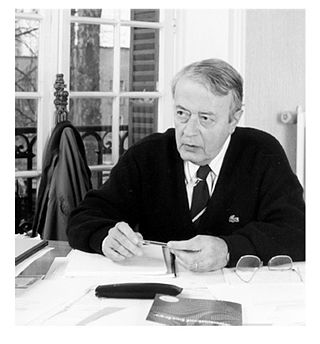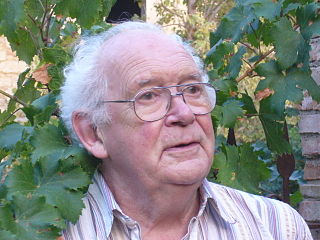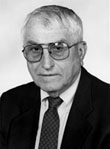Bayesian probability is an interpretation of the concept of probability, in which, instead of frequency or propensity of some phenomenon, probability is interpreted as reasonable expectation representing a state of knowledge or as quantification of a personal belief.
Geostatistics is a branch of statistics focusing on spatial or spatiotemporal datasets. Developed originally to predict probability distributions of ore grades for mining operations, it is currently applied in diverse disciplines including petroleum geology, hydrogeology, hydrology, meteorology, oceanography, geochemistry, geometallurgy, geography, forestry, environmental control, landscape ecology, soil science, and agriculture. Geostatistics is applied in varied branches of geography, particularly those involving the spread of diseases (epidemiology), the practice of commerce and military planning (logistics), and the development of efficient spatial networks. Geostatistical algorithms are incorporated in many places, including geographic information systems (GIS).

Geologic modelling,geological modelling or geomodelling is the applied science of creating computerized representations of portions of the Earth's crust based on geophysical and geological observations made on and below the Earth surface. A geomodel is the numerical equivalent of a three-dimensional geological map complemented by a description of physical quantities in the domain of interest. Geomodelling is related to the concept of Shared Earth Model; which is a multidisciplinary, interoperable and updatable knowledge base about the subsurface.

The Kansas Geological Survey (KGS), a research and service division of the University of Kansas, is charged by statute with studying and providing information on the geologic resources of Kansas. The KGS has no regulatory authority and does not take positions on natural resource issues.
Peter Whittle was a mathematician and statistician from New Zealand, working in the fields of stochastic nets, optimal control, time series analysis, stochastic optimisation and stochastic dynamics. From 1967 to 1994, he was the Churchill Professor of Mathematics for Operational Research at the University of Cambridge.

Spatial analysis or spatial statistics includes any of the formal techniques which studies entities using their topological, geometric, or geographic properties. Spatial analysis includes a variety of techniques, many still in their early development, using different analytic approaches and applied in fields as diverse as astronomy, with its studies of the placement of galaxies in the cosmos, to chip fabrication engineering, with its use of "place and route" algorithms to build complex wiring structures. In a more restricted sense, spatial analysis is the technique applied to structures at the human scale, most notably in the analysis of geographic data or transcriptomics data.

Georges François Paul Marie Matheron was a French mathematician and civil engineer of mines, known as the founder of geostatistics and a co-founder of mathematical morphology. In 1968, he created the Centre de Géostatistique et de Morphologie Mathématique at the Paris School of Mines in Fontainebleau. He is known for his contributions on Kriging and mathematical morphology. His seminal work is posted for study and review to the Online Library of the Centre de Géostatistique, Fontainebleau, France.

John Aitchison was a Scottish statistician.
A petroleum geologist is an earth scientist who works in the field of petroleum geology, which involves all aspects of oil discovery and production. Petroleum geologists are usually linked to the actual discovery of oil and the identification of possible oil deposits, gas caps, or leads. It can be a very labor-intensive task involving several different fields of science and elaborate equipment. Petroleum geologists look at the structural and sedimentary aspects of the stratum/strata to identify possible oil traps or tight shale plays.

The geology of Kansas encompasses the geologic history and the presently exposed rock and soil. Rock that crops out in the US state of Kansas was formed during the Phanerozoic eon, which consists of three geologic eras: the Paleozoic, Mesozoic and Cenozoic. Paleozoic rocks at the surface in Kansas are primarily from the Mississippian, Pennsylvanian, and Permian periods.

Digital geologic mapping is the process by which geological features are observed, analyzed, and recorded in the field and displayed in real-time on a computer or personal digital assistant (PDA). The primary function of this emerging technology is to produce spatially referenced geologic maps that can be utilized and updated while conducting field work.

The International Association for Mathematical Geosciences (IAMG) is a nonprofit organization of geoscientists. It aims to promote international cooperation in the application and use of mathematics in geological research and technology. IAMG's activities are to organize meetings, issue of publications on the application of mathematics in the geological sciences, extend cooperation with other organizations professionally concerned with applications of mathematics and statistics to the biological sciences, earth sciences, engineering, environmental sciences, and planetary sciences. IAMG is a not for profit 501(c)(3) organization.
The William Christian Krumbein Medal is the highest award given alternate years by the International Association for Mathematical Geosciences (IAMG) to senior scientists for career achievement, which includes (a) distinction in application of mathematics or informatics in the earth sciences, (b) service to the IAMG, and (c) support to professions involved in the earth sciences. There is no stipulated preference for fields of application within the earth sciences. The William Christian Krumbein Medal, named after William Christian Krumbein, was established in 1976.

John Warvelle Harbaugh (1926-2019) was an American geologist who spent most of his professional career at Stanford University devoted to research on mathematical modeling of dynamic systems, sedimentary basin simulation and oil exploration risk analysis. Since 1999, he is Professor Emeritus both at the Geological and Environmental Sciences Department and at the Energy Resources Engineering Department.
He received numerous honors and awards for his accomplishments and service to the profession that include the Haworth Distinguished Alumni Award of University of Kansas (1968), the A.I. Levorsen Award (1970) from the Pacific Section of the American Association of Petroleum Geologists (AAPG), the Distinguished Service Award also from AAPG (1987), the William Christian Krumbein Medal from International Association for Mathematical Geosciences (1986), and the Distinguished Alumni Award from the University of Wisconsin–Madison (2003). In 2001, his colleagues and friends presented him with a festschrift. In 2013, the International Association for Mathematical Geosciences elected him as Honorary Member.

Vera Pawlowsky-Glahn is a Spanish-German mathematician. From 2000 till 2018, she was a full-time professor at the University of Girona, Spain in the Department of Computer Science, Applied Mathematics, and Statistics. Since 2018 she is emeritus professor at the same university. She was previously an associate professor at Technology University in Barcelona from 1986 to 2000. Her main areas of research interest include statistical analysis of compositional data, algebraic-geometric approach to statistical inference, and spatial cluster analysis. She was the president of the International Association for Mathematical Geosciences (IAMG) during 2008–2012. IAMG awarded her the William Christian Krumbein Medal in 2006 and the John Cedric Griffiths Teaching Award in 2008. In 2007, she was selected IAMG Distinguished Lecturer.
During the 6th International Workshop on Compositional Data Analysis in June 2015, Vera was appointed president of a commission to formalize the creation of an international organization of scientists interested in the advancement and application of compositional data modeling.

Ricardo Antonio Olea is a Chilean American who was a research mathematical statistician with the United States Geological Survey (2006–21). Previously, he spent most of his career with the National Oil Company of Chile (ENAP) in Punta Arenas and Santiago, and with the Kansas Geological Survey in Lawrence. He received the William Christian Krumbein Medal in 2004 from the International Association for Mathematical Geosciences. He served as Secretary-General (1992−1996) and President (1996–2000) for the International Association for Mathematical Geosciences; and Secretary General (2019–21) of the Compositional Data Association.
Daniel Francis Merriam was an American geologist best known for fostering the development of quantitative modeling in geology after the advent of digital computers. He first joined the Kansas Geological Survey in 1953, initially working under the direction Raymond C. Moore to have a more accurate knowledge about the geology of the state. His fascination with the new possibilities offered by computers started ten years later while working with John W. Harbaugh at Stanford University as Visiting Research Scientist. In the following seven years, he was active organizing colloquia and as editor of the Computer Contributions, who saw 50 publications in the series by pioneers in the new field. Merriam accepted the position of Chairman of the Department of Geology at Syracuse University in 1971 and moved to the same position at Wichita State University in 1981, coming back to the Kansas Geological Survey in 1991 to retire in 1997, remaining as an Emeritus Scientist.

Jef Caers, born in Belgium, is an academic working as a Professor at the School of Earth, Energy & Environmental Sciences, Stanford University. He was awarded the Andrei Borisovich Vistelius Research Award and the William Christian Krumbein Medal by the International Association for Mathematical Geosciences in 2001 and 2014 respectively. He is Editor-in-Chief of Computers & Geosciences.
Noel Andrew Cressie is an Australian and American statistician. He is Distinguished Professor and Director, Centre for Environmental Informatics, at the University of Wollongong in Wollongong, Australia.
Graeme Bonham-Carter is a UK-born Canadian mathematical geologist. He served as president of the International Association for Mathematical Geosciences (IAMG) from 2000 to 2004. He was Editor-in-Chief of the journal Computers & Geosciences from 1996 to 2005. He received the William Christian Krumbein Medal in 1998 from the IAMG.











